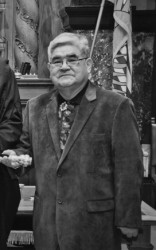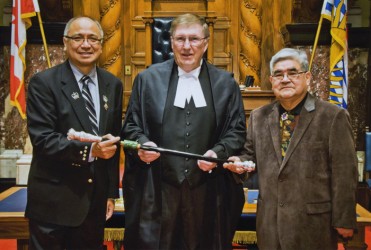Article Origin
Volume
Issue
Year
Kitsumkalum chief strategized cultural and political renewal
Former Kitsumkalum Chief Clifford Bolton was a master carver, known for gallery and museum-quality art. His 1987 event to amalgamate his people and thwart government interference was politically creative.
For two centuries his people had almost lost themselves under assimilative pressures from traders, missionaries, and government authorities. The four clans of his Tsimshian Nation – eagle, raven, killer whale and wolf – were fragmented as they moved from traditional social organization to modern living under foreign laws in a rapidly expanding industrial economy.
The Indian Act had further served to divide families within his Tsimshian Nation by giving some individuals Indian Status and deeming others as non-status people.
To remedy some of the disintegration of familial relations and bring people together, Bolton helped organize Su-Sit’Aak, which in his sm’algyax language means “a new beginning.” It involved the raising of two totem poles and staging a potlatch, events that had not occurred in the Kitsumkalum Valley for more than 150 years.
Bolton strategized the event to give his people a chance to re-unite and express themselves as a community. He took care to ensure the central planning committee consisted of diverse individuals from throughout his nation, and volunteer members were drawn from the major social sub-groups in Kitsumkalum. Different families, clans, status and non-status people, special interest groups, Elders and elected representatives came together to decide everything from how the totem poles would be raised, who would be seated where, and how the food would be prepared and served.
On Aug. 1, 1987 more than 2,000 people gathered to celebrate Su-Sit’Aak and Bolton explained to the crowd that Canadian laws had made it difficult for the Tsimshian to retain their culture. This celebration was his generation’s way of telling the children that the next generation will have to be prepared to fight for the survival of their culture.
“We decided we would do this totem pole raising some years back because we felt it was important that our people start over again in bringing back our culture,” he said in an interview with the Native Music Heritage Society in 1987. “With all the preparations and learning of the old traditional ways to the best of our ability, Su-sit’Aatk is a new beginning for our people. It’s very exciting because there is a lot that had been forgotten. It didn’t totally die out because it had been always around all this time, but now it’s coming to the surface.”
The chief explained to the crowd that one of the poles had all the major crests on it to represent the whole community and was dedicated to the children to signify the future. The other one was a replica of an older pole and displayed the crests of one of the ancient families of Kitsumkalum. It represented the past and honoured Elders who had died, the cultural heritage of the ancestors, and the generations that suffered during the period of harsh Canadian assimilation policies.
Though the potlatch may not have led directly to self government, it did serve to strengthen awareness about Aboriginal rights. It started the Tsimshian Nation thinking about organizing a political forum for expressing their needs over and above what the government had deemed was good for them.
After working in several government departments in Terrace, Prince Rupert and Vancouver, Bolton was well-prepared to lead Kitsumkalum in 1981.
“He did the early legwork in negotiating the terms or our treaties and our land claims,” recalls Steven Roberts, his nephew. “When the government introduced the white paper, he helped unify leaders to create the Union of B.C. chiefs to oppose it.
“He had a good education and was well-prepared to fight for and protect our treaty rights. He wanted our people to have a fair deal and he worked hard to negotiate our stance. In terms of economic development, he helped establish a fish hatchery and other businesses in Kitsumkalum.”
Bolton worked his way up the ranks, having worked at all kinds of jobs in his youth, said Roberts. “He worked as a taxi driver, a construction worker, you name it. Anything he took up he seemed to do well at. When he was a young man his army cadet troupe came second in the world for rifle target shooting.”
Roberts said his uncle learned about lapidary work in a foster family he lived with and he began working with semi-precious stone early in life. One of his last projects was to carve a decoration out of jade for the Lieutenant Governor’s new black rod which serves as a symbol of his office. He presented it to Steven Point, his step-son, who is the current Lieutenant Governor in the BC legislature.
As a child growing up in Port Essington on the north coast of Vancouver Island, Bolton began carving model canoes and small model totem poles. In 1976, he began to produce full size canoes with Mark Point of the Sto:lo First Nation. By 1981 he was collaborating with master carvers like Dempsey Bob and Freda Diesing, learning different styles.
“He was my go-to man if we needed Tsimshian display pieces for our living cultural centre,” said Web Bennett, coordinator of the Kitselas Canyon Native Historic Site. In 2010 he helped arrange for Bolton to lead four carvers in producing a war canoe.
“It was an intense program. The group started in August of that year and completed the carving and painting of the canoe from a solid piece of cedar four months later.
“Cliff was an elder very willing to share and pass on the skills he’d learned as a master carver. When he found a young person who had the desire to learn, he was more than happy to act as a mentor,” Bennett added.
Bolton was involved with other master carvers in guiding the art program at the Freda Diesing School of Northwest Coast Art at the Northwest Community College.
“It’s been so successful, I’d say we have eight to 10 outstanding new carvers. Ten to 15 years ago, I would say we only had two prominent carvers in this area,” Bennett commented.
Bolton had a good sense of humour and many people say they’ve never seen him get angry, said Roberts. “But I saw him get gruff when he was trying to get a good deal for our people in government meetings of the mid-80s. He knew the system and he never let anyone mislead him.”
Roberts described his uncle as a man who “lived a clean life”. Bolton was involved in his community right up until about four weeks ago when he complained of being tired. He suffered a stroke, was hospitalized, and died on April 12.
He was married to Rena Point Bolton, a master weaver. The couple had one son together.
- 4679 views


